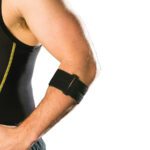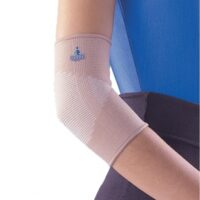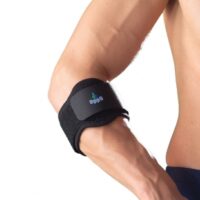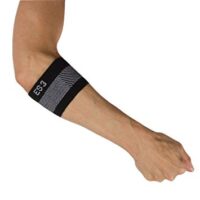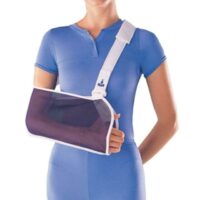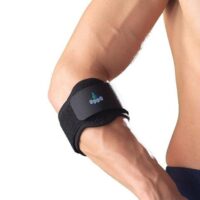Golfers Elbow
Article by John Miller

Golfers Elbow
Medial Epicondylalgia
What is Golfer’s Elbow?
Golfer’s elbow, also known as medial epicondylalgia, is a common injury that affects the muscles responsible for flexing the wrist and fingers. The injury occurs at the medial epicondyle, a bony bump on the inside of the elbow where these muscles attach.
Golfer’s Elbow Symptoms
The symptoms of golfer’s elbow include pain during gripping tasks, resisted wrist/finger flexion, and overstretching of the affected muscles. Tenderness at the medial epicondyle and trigger points in the wrist flexor muscles may also be present.

What Causes Golfer’s Elbow?
Excessive force applied to the arm bone’s attachment point at the elbow causes Golfer’s elbow by damaging the muscle tissue. Degenerative tendon tissue changes at the medial epicondyle, not inflammation, link to chronic golfer’s elbow.
How is Golfer’s Elbow Diagnosed?
Your physiotherapist or doctor clinically diagnoses your golfer’s elbow. After listening to your injury history and using some confirmatory clinical tests, they’ll make a provisional diagnosis of Golfer’s Elbow.
Referred pain from a cervical spine injury can mimic golfer’s elbow, so it is important to have the neck and upper limb neurodynamics assessed by an experienced physiotherapist to confirm or exclude any neck dysfunction or neural tension.
An ultrasound scan or MRI are the best tests to identify any tendon tears or inflammation. X-rays are of little diagnostic benefit.
Golfer’s Elbow Treatment
Golfer’s elbow can be challenging to treat due to the tendinopathy component involved. Physiotherapy is effective in the short and long-term management of golfer’s elbow, with treatment options including gentle joint mobilisation, protective strapping, muscle stretches, neural mobilizations, massage, strengthening exercises, and the use of a golfer’s elbow brace. Treatment aims to reduce elbow pain, facilitate tissue repair, restore full joint range and function, ensure adequate muscle length, strength, and movement patterns, and normalize upper limb neurodynamics and cervical joint function.
Untreated chronic golfer’s elbow can last anywhere from six months to two years and can recur, so it is essential to seek the advice of an elbow physiotherapist for diagnosis and treatment options to prevent the condition from becoming chronic. Overall, seeking professional advice and customising the treatment plan to suit the individual’s needs is crucial in the effective management of golfer’s elbow.
Golfers Elbow Brace
A golfers elbow brace is more commonly referred to as a tennis elbow brace. It can be beneficial. In these instances, the elbow brace will dissipate the stressful gripping forces away from your injured structures.
However, tennis elbow braces do not work in 100% of cases. In our experience, we recommend that you seek physiotherapy assistance in these cases. In stubborn cases, you have a very high likelihood of referred symptoms from your spine or joint position abnormalities within your elbow. Only a thorough examination of your neck, shoulder, elbow and upper limb nerve structures will confirm your diagnosis and direct which treatment options will assist you the quickest.
Please seek the professional advice of your trusted elbow physiotherapist regarding your golfer’s elbow.
Rochedale - Call 38410277
Book Online: RochedaleSalisbury - Call 32751044
Book Online: SalisburySandgate - Call 32691122
Book Online: SandgateRelated Articles
- Tennis Elbow – Readers will discover in-depth information on tennis elbow, highlighting causes, symptoms, and effective treatment options.
- Elbow Pain – This article provides insights into various elbow pain causes, including golfer’s and tennis elbow, and their management.
- Repetitive Strain Injury (RSI) – Offers information on common wrist and elbow injuries, including golfer’s elbow, and discusses management strategies.
- Soft Tissue Injury Healing – Explains the phases of injury healing and how physiotherapy can improve outcomes, relevant to golfer’s elbow recovery.
- Arm Pain – Discusses common causes of arm pain, including golfer’s elbow, and offers insights into diagnosis and treatment.
- Tennis Elbow Strap – Golfers Elbow Relief – Though focused on tennis elbow, it provides insights into elbow braces which can be beneficial for golfer’s elbow sufferers.
- Post-Operative Rehabilitation – While not directly related to golfer’s elbow, it discusses the importance of physiotherapy in recovery, which could be useful for severe cases requiring surgery.
- Rowing Injuries Prevention And Management Tips – Includes general tips for injury prevention and management that could be applied to golfer’s elbow.


